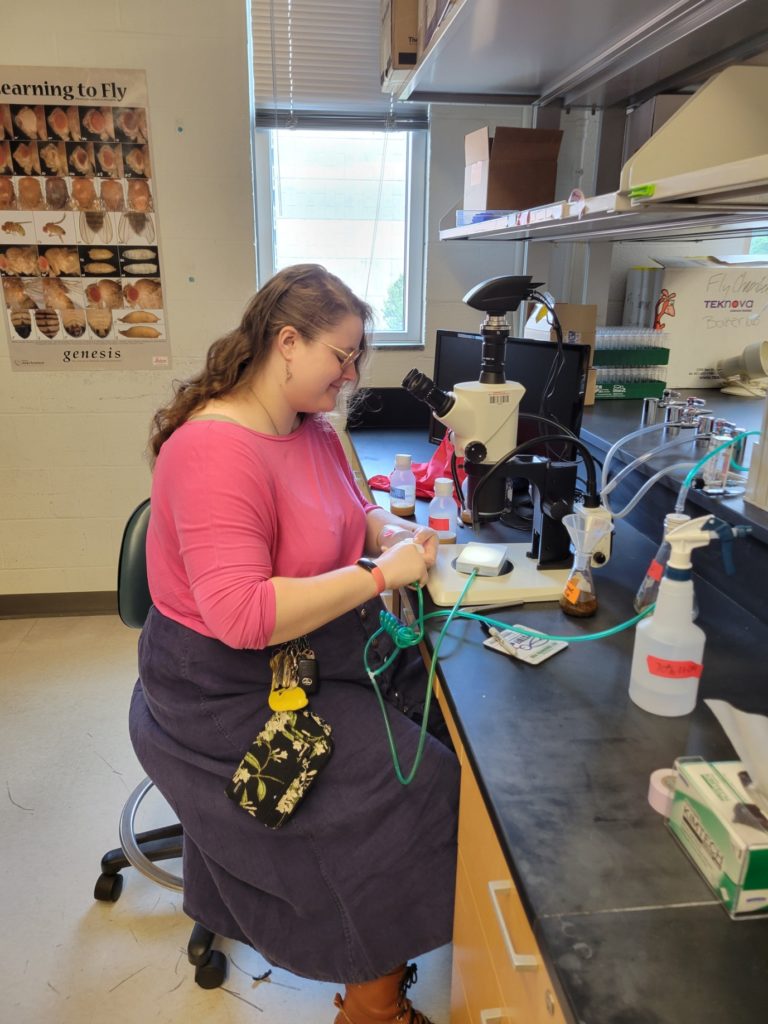Communication comes in all forms – through sound, smell, sight, touch, or even taste. The purpose of communication is to share some form of message or information to another organism. One form of communication between humans is talking, which is when we make a variety of noises as we speak using language. Just like people, animals make all kinds of noises to communicate with one another.
The tiny fruit flies that live on the ripe banana in your kitchen communicate as well. They use a courtship song when they are ready to mate. The male fly shakes his wings to sing a song to the female fly. The female fly hears the song, her brain processes the sound, and then she responds. Her brain decides whether she likes him or not. She may then try to kick him away or let him get closer.
Emma is a neuroscientist who is really interested in studying how brains are able to understand all kinds of communication. She uses fruit flies to figure out how brains process communication through sounds. Even though the fly brain is very small, they work a lot like human brains, so studying tiny flies singing to each other can help us understand our own brains.
While researching what other scientists had already learned about fly song, Emma read studies that described an interesting behavior called chaining. Chaining is a behavior when males chase and sing to each other. The scientists first observed this behavior when they played a fly song through a speaker for a group of 6 male flies. Emma wanted to see if she could repeat this behavior in her own lab. An important part of science is repeating experiments to make sure the results are accurate and can be achieved again and again. Repeating experiments can also be a way to test that another scientist’s methods work in your lab.

There are lots of things in the lab environment that can impact how a fly reacts to a song. Emma wants to pick a few variables to test. The first variable she selected is the volume of the courtship song being played. Emma decided to test different volumes to see how loudly she should play the fly song to get a response.
Since Emma couldn’t ask the flies if they could hear the sounds she played through her speaker, she measured chaining behavior instead. If the flies heard the sound from her recordings, she expected to see more chaining behavior.
Volume isn’t the only variable she can explore though. Imagine you are listening to a song and the singer sings a word you haven’t heard before. Do you think you’d be able to understand the word? The same thing may apply to the flies. Emma wanted to know if flies would react differently if they had been around other flies that sing. To test this, Emma raised some flies alone and others in groups. That way, she could see if being around other flies before the test made the song easier to recognize.
To gather her data, Emma put 6 male flies into a chamber with a clear top. She placed the chamber in front of a speaker. She also set up a camera to take a video of the flies for a minute before the song played and for a minute after the song began. This two-minute video allowed her to compare the flies’ behavior in silence with their behavior when the song plays. Then, Emma watched the video back and counted the number of flies that were chasing each other every 3 seconds. She did this for one whole minute (20 observation points) to get a chaining index for each group of flies.
Featured scientist: Emma Droste (she/her) from North Carolina State University
Flesch–Kincaid Reading Grade Level = 7.2
Students can listen to this audio clip of fly song and think about what these sounds may be communicating. The audio clip was generated by having a mating pair directly over a very sensitive microphone to capture the audio since it is not audible to the human ear.

